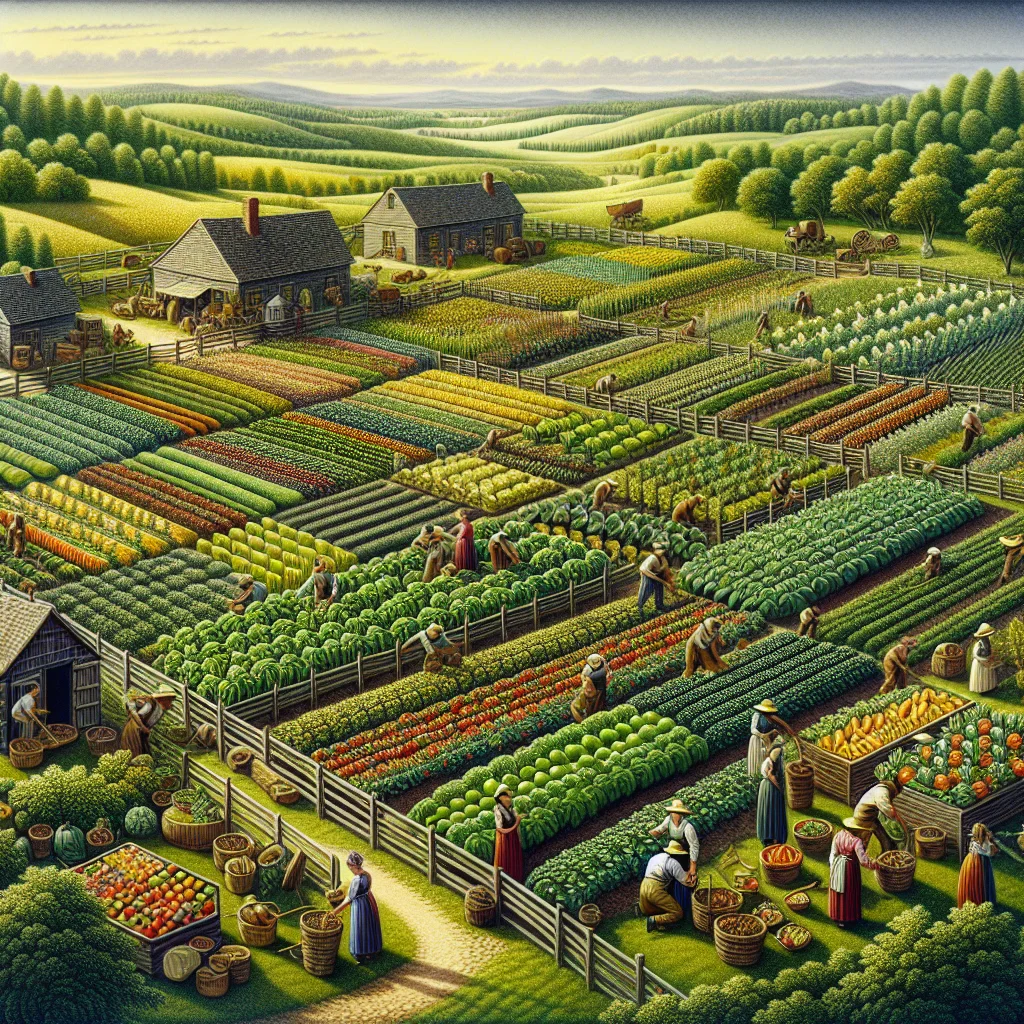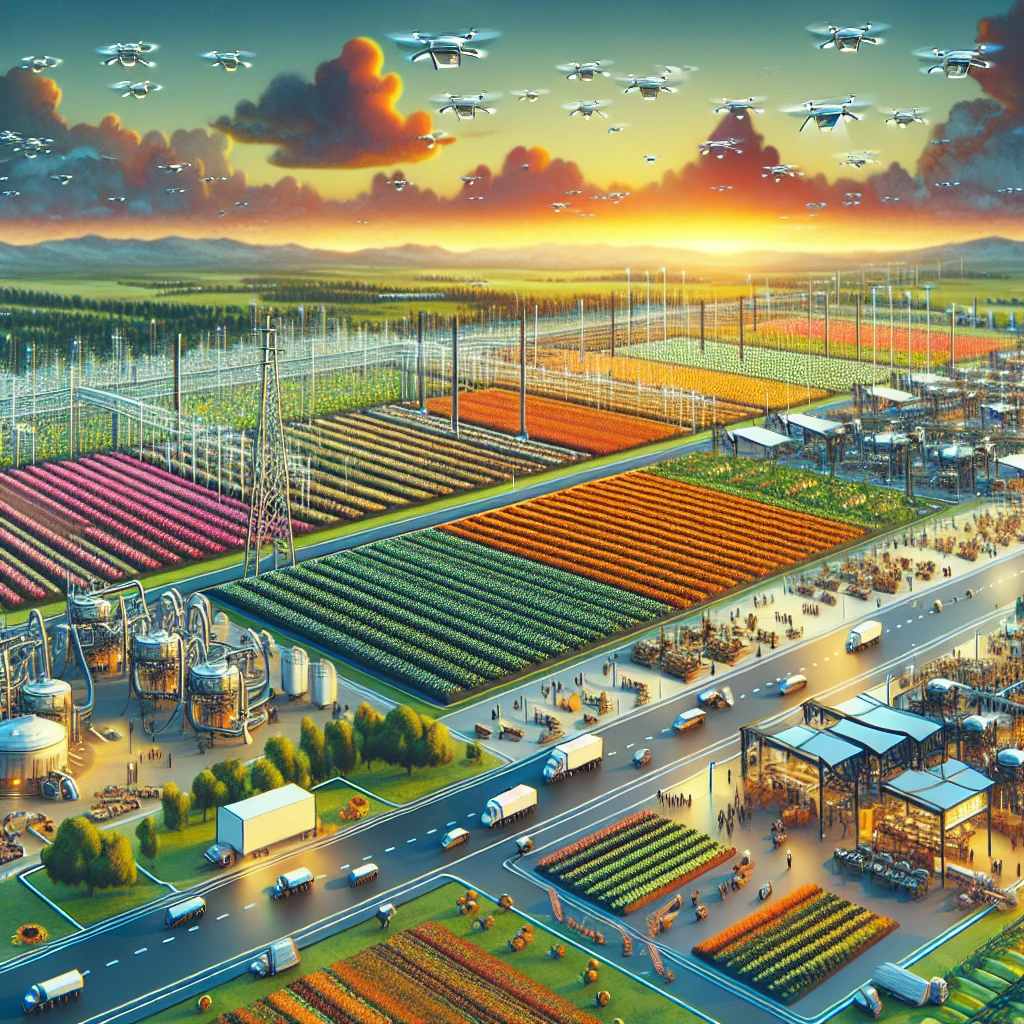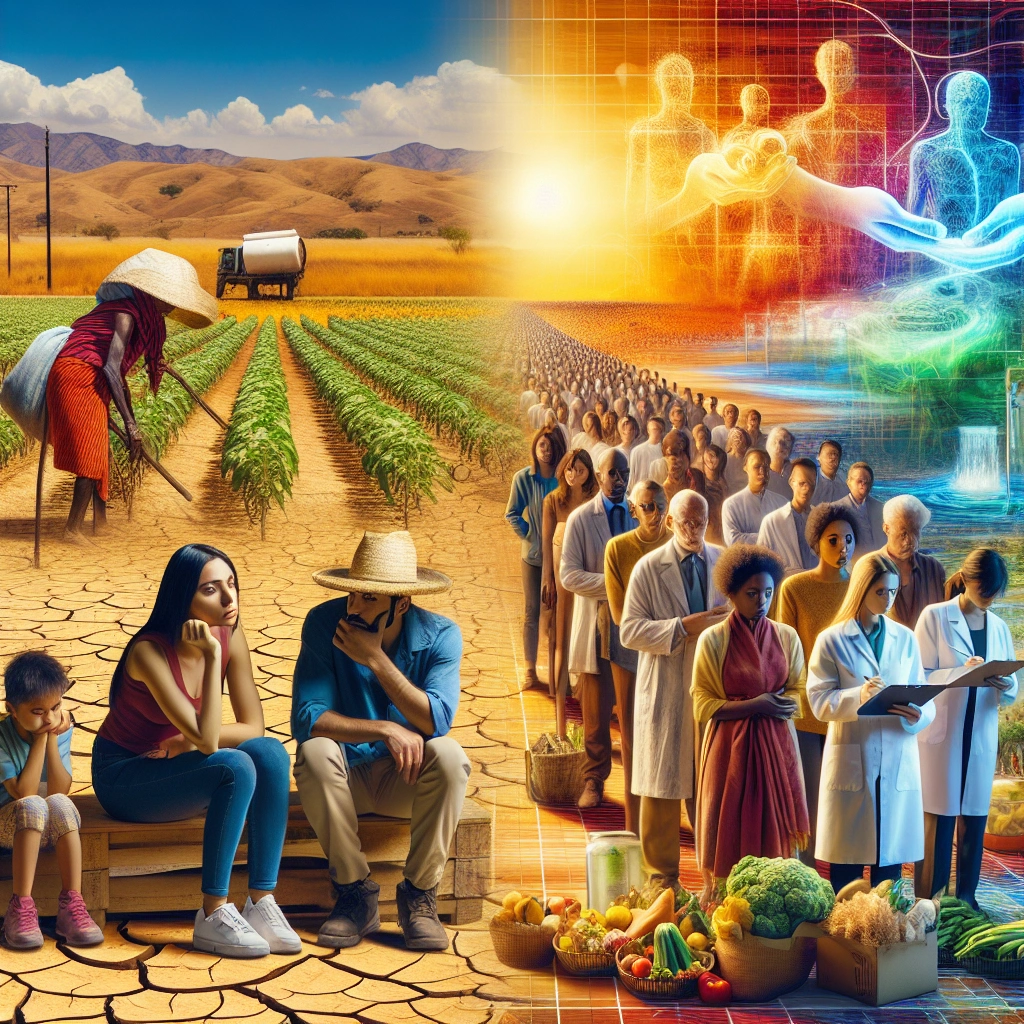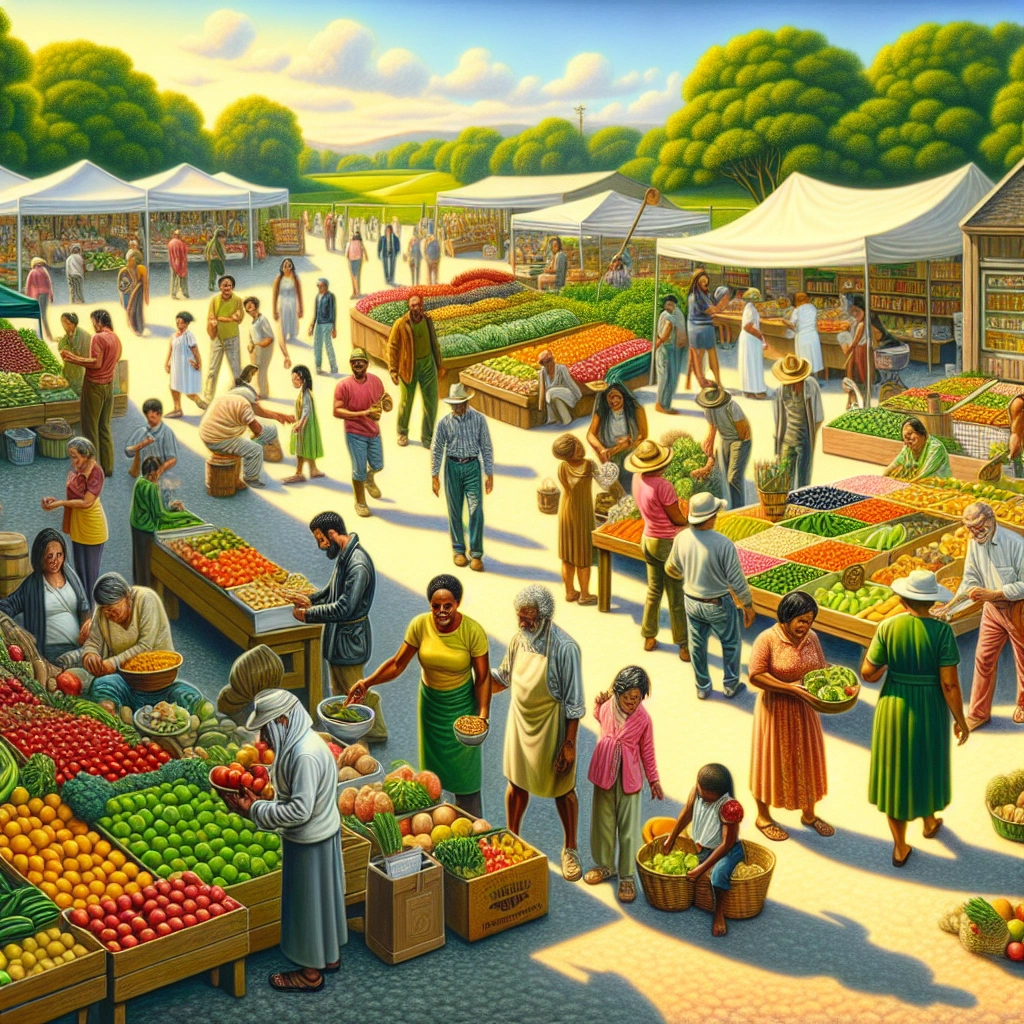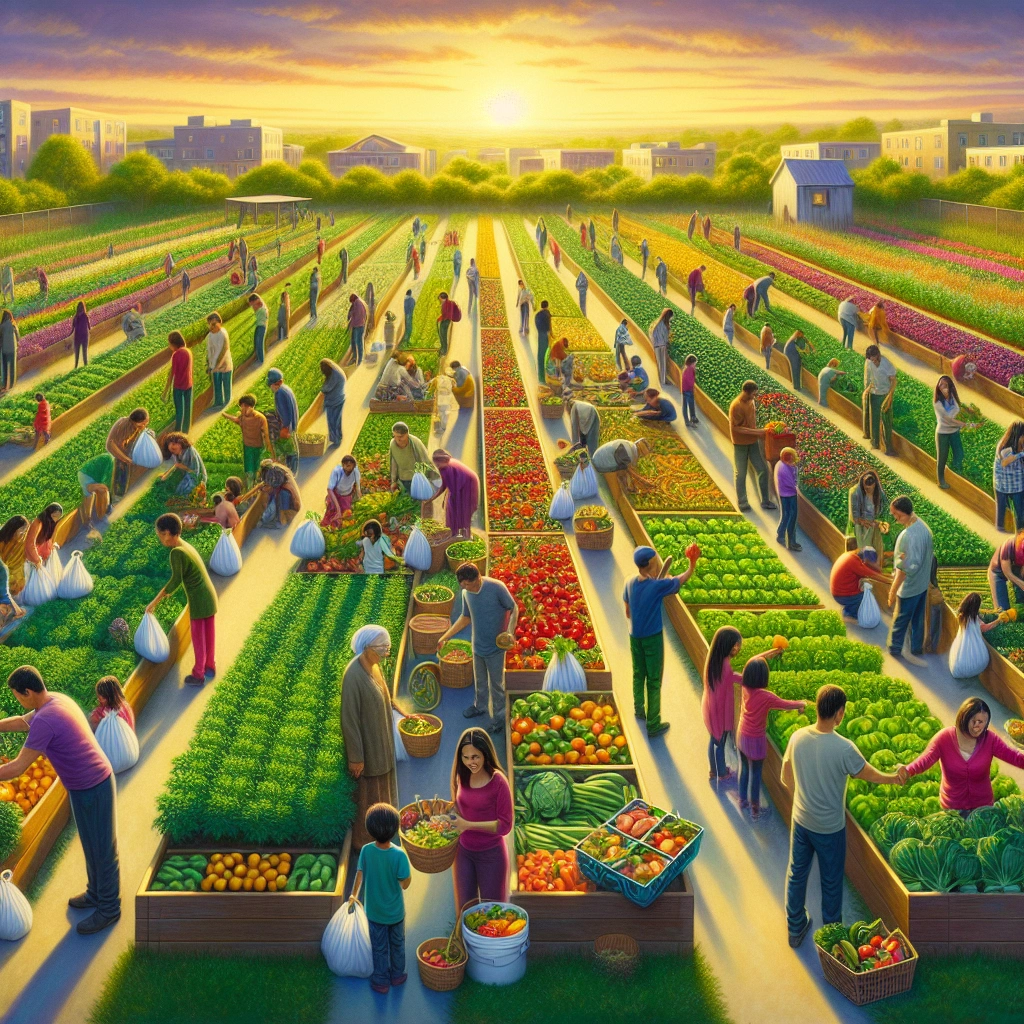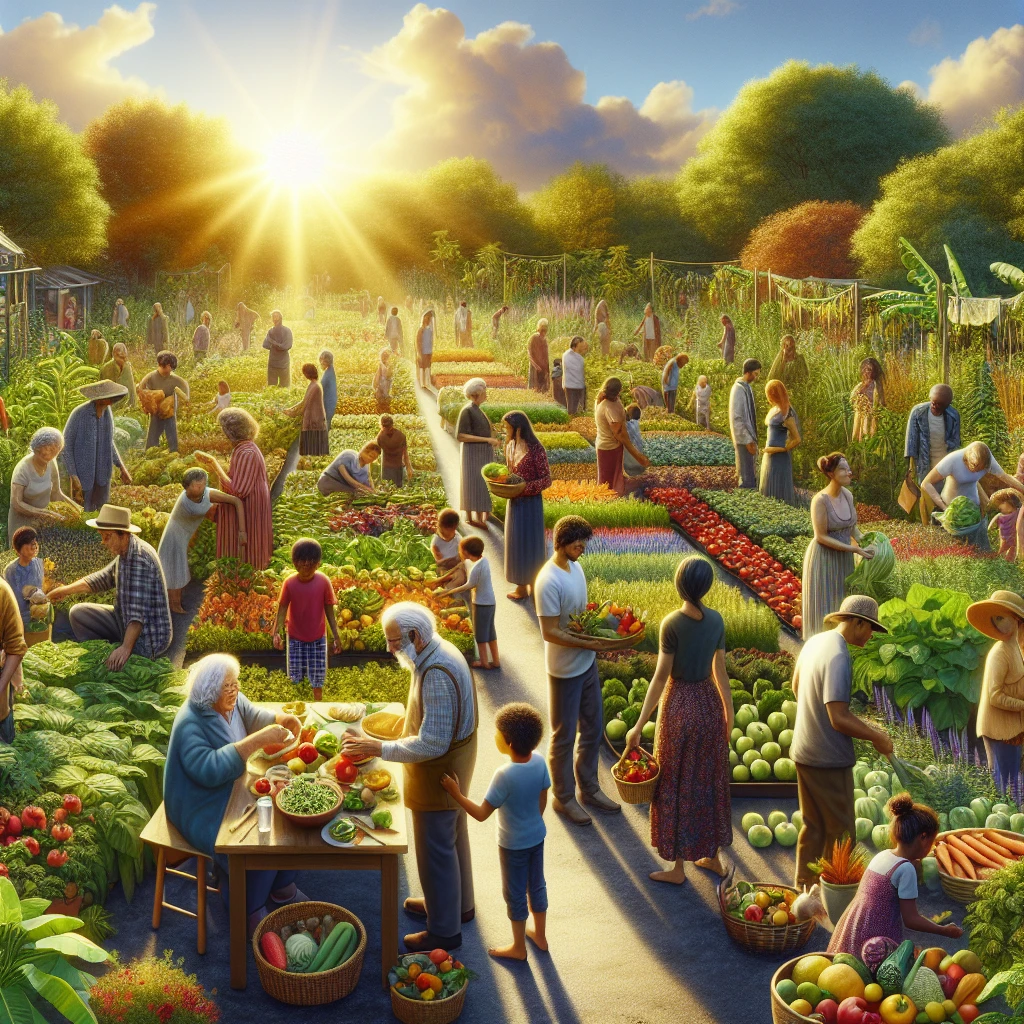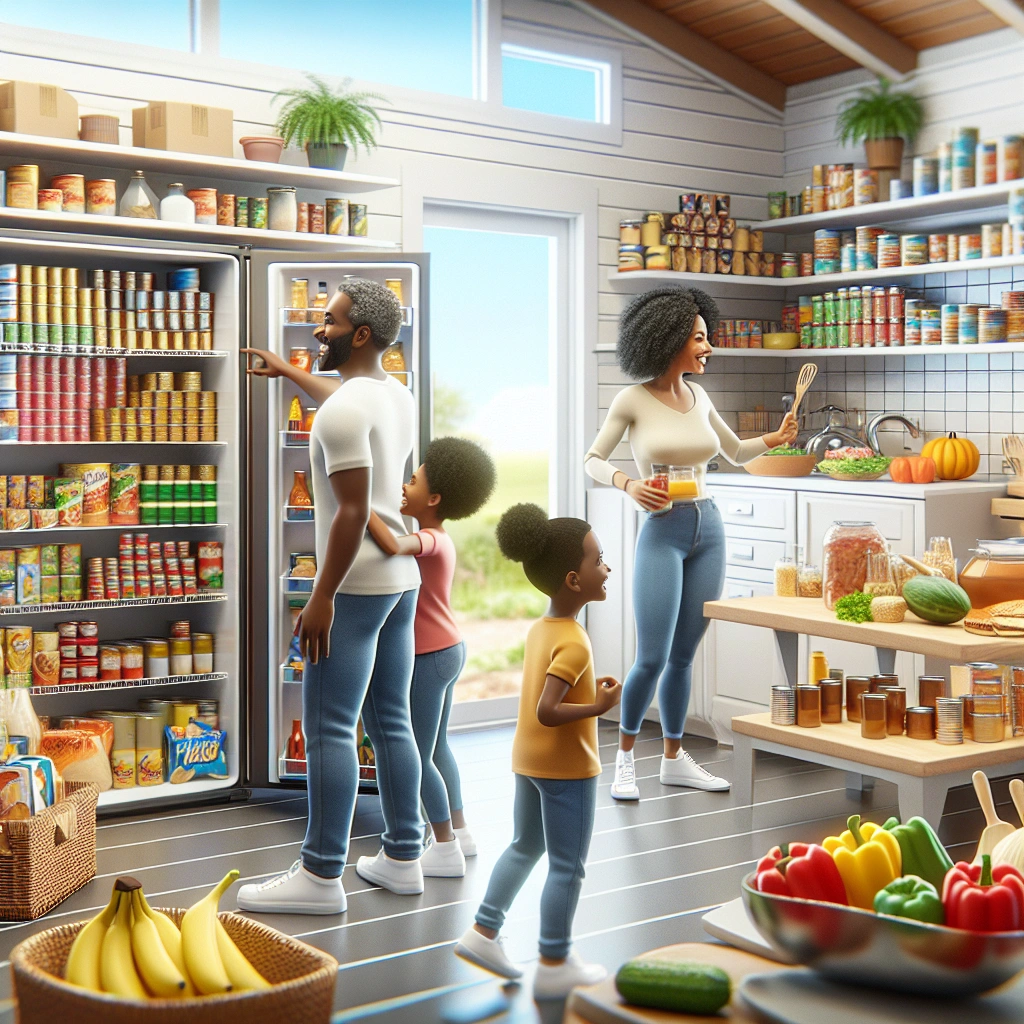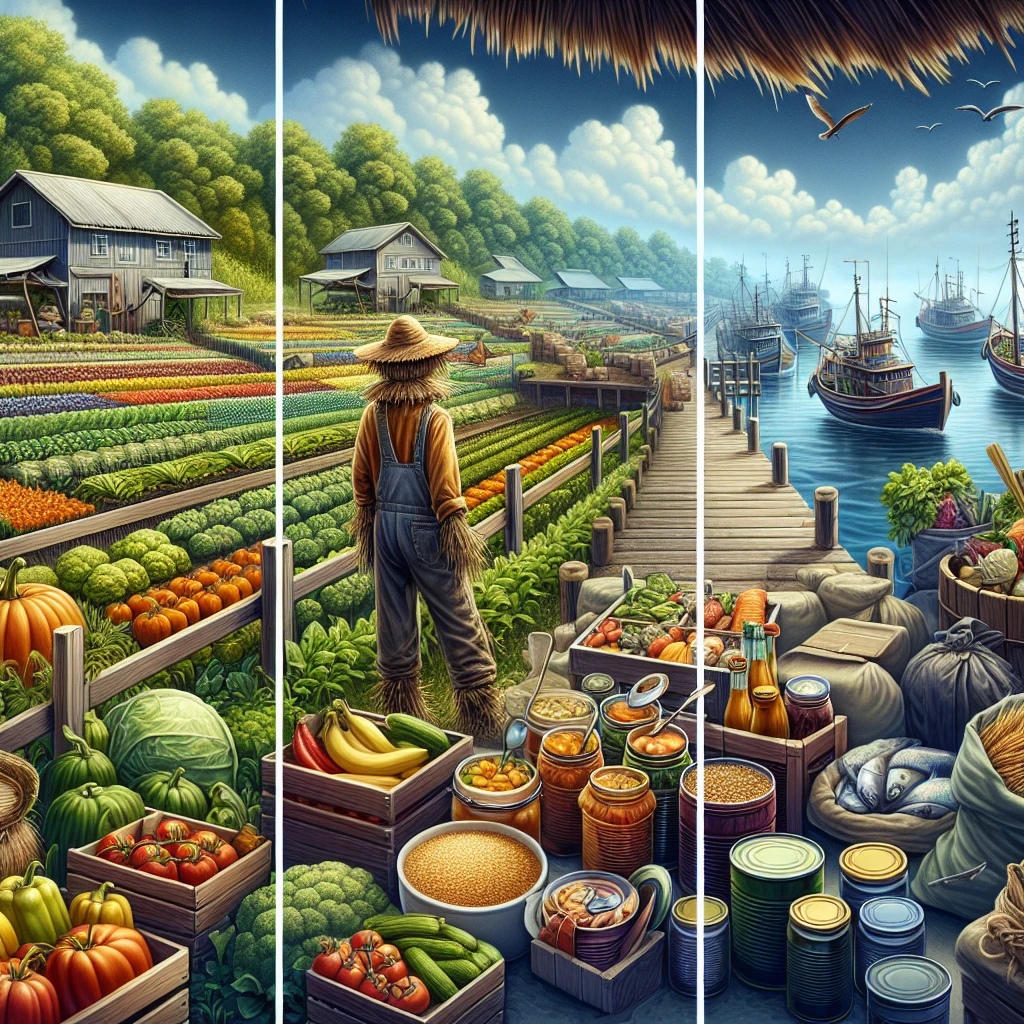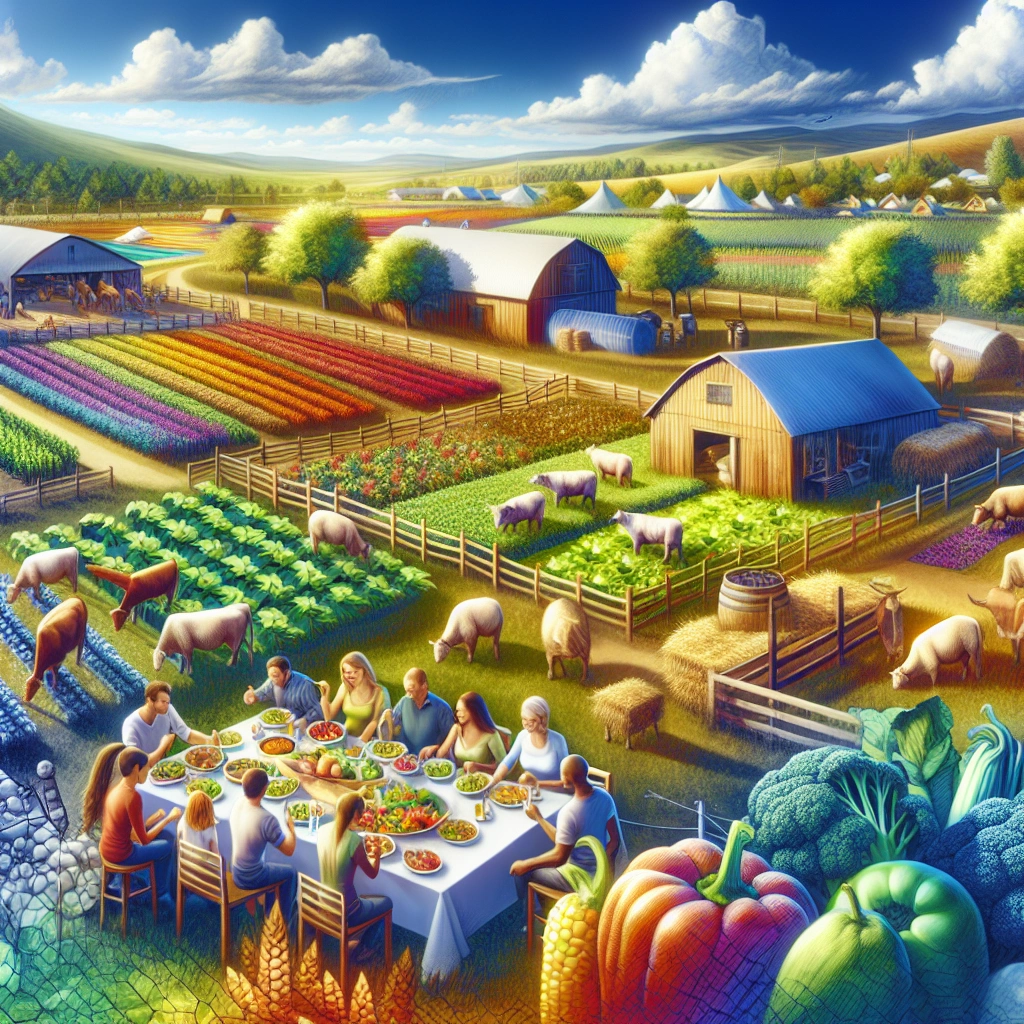

Food security refers to the condition where all people have physical and economic access to sufficient safe and nutritious food at all times. This encompasses the ability to meet dietary needs and food preferences for an active and healthy life.
Understanding food security is crucial as it directly impacts the well-being of individuals and communities, as well as the stability of nations and the global population. It involves addressing factors such as economic access to food, food production, domestic supplies, and the overall governance of food systems.
Check out this Youtube video: “What is food security?” to gain a deeper understanding of the importance of food security in today’s society and how it affects our global community.
Understanding Food Security
Access to food
Food security involves access to a sufficient quantity of affordable, nutritious food. It’s not just about the physical availability of food, but also the ability of individuals to acquire it.
Factors such as location, transportation, and income levels play crucial roles in determining access to food. For example, food deserts in urban areas limit the availability of fresh produce, impacting access to healthy food choices for residents.
Availability of food
The availability of food pertains to the physical presence of food within a given region or community. This includes the supply side of food security, determined by factors such as food production, stock levels, and distribution networks.
For instance, regions with limited agricultural productivity may struggle to ensure a consistent supply of food for their populations, leading to food shortages and increased food insecurity.
Utilization of food
Utilization of food relates to the proper consumption and utilization of available food to meet dietary and nutritional needs. It’s not just about having access to food, but also about consuming it in a way that promotes health and well-being.
Proper food utilization involves considerations such as dietary diversity, cultural preferences, and food safety practices, ensuring that individuals can make the most of the food they have access to.
Stability of food access
Stability of food access refers to the ongoing, reliable availability of food over time, without significant fluctuations or disruptions. This aspect of food security emphasizes the need for consistent access to food resources, free from sudden shortages or unpredictable conditions.
For example, regions prone to natural disasters or economic instability may struggle to maintain stable access to food, leading to heightened levels of food insecurity.
| Dimensions of Food Security | Definition |
|---|---|
| Physical availability of food | Refers to the supply side of food security and is determined by levels of food production, stock levels, and distribution networks. |
| Economic and physical access to food | Encompasses affordability, location, transportation, and income levels, impacting individuals’ ability to acquire food. |
| Utilization of food | Involves consuming food in a way that meets dietary and nutritional needs, considering factors such as dietary diversity and food safety. |
| Stability of food access | Ensures ongoing and reliable access to food over time, without significant fluctuations or disruptions. |
These dimensions collectively contribute to a comprehensive understanding of food security, addressing the multifaceted nature of ensuring access to sufficient, safe, and nutritious food for all individuals and communities.
What is Food Security
Food security refers to the state in which all individuals have physical and economic access to sufficient, safe, and nutritious food to meet their dietary needs for an active and healthy life. It encompasses the availability, accessibility, utilization, and stability of food over time, ensuring that people can obtain and consume food that contributes to their overall well-being and health.
Definition of food security
The definition of food security revolves around the guarantee that everyone has consistent access to enough nutritious food to maintain a healthy and active lifestyle. It’s not just about the presence of food but also the accessibility and utilization of that food.
The four dimensions of food security
-
Physical availability of food: This dimension focuses on the production, distribution, and stock levels of food, ensuring a continuous supply to meet the dietary needs of the population.
-
Economic and physical access to food: This dimension delves into the affordability and physical accessibility of food. It’s not just about the presence of food in the market but also about individuals’ capability to purchase it.
-
Food utilization: Food utilization looks at the appropriate use of food, including knowledge of basic nutrition, proper care, and access to water and sanitation for food preparation, leading to overall good health and nutrition.
-
Stability over time: Stability over time pertains to the consistency and predictability of these three dimensions. It’s essential that food security remains constant over various time frames, without any sudden disruptions.
Physical availability of food
The physical availability of food is critical as it directly impacts the overall supply and stock levels. Without proper physical availability, ensuring food security becomes challenging, particularly in times of natural disasters, wars, and other emergencies.
Economic and physical access to food
Economic and physical access to food is just as crucial as the physical availability. It’s not only about the presence of food but also about the ability of individuals to afford and physically reach the food sources.
Economic factors, race, ethnicity, education, and other social determinants heavily impact this dimension.
Food utilization
Food utilization is about more than just consuming food; it’s about consuming a nutritious diet. Proper use of food, based on knowledge of basic nutrition, access to water, and proper hygiene, greatly influences the nutritional status of individuals, ensuring overall well-being.
Stability over time
Stability over time is key to ensuring that food security remains steadfast across various scenarios, preventing sudden disruptions and allowing individuals and communities to maintain consistent access to nutritious food for their well-being.
Why is Food Security Important
Food security is crucial for both individuals and communities, as it directly impacts their health and well-being. When people have reliable access to nutritious food, it helps in reducing the risk of chronic health conditions such as diabetes, obesity, heart disease, and mental health disorders. Moreover, food security plays a vital role in ensuring the overall health and productivity of communities, leading to a more vibrant and engaged society.
Impact of food security on individuals and communities
Food security has a direct impact on the physical and mental well-being of individuals and communities. When people have access to nutritious food, they are more likely to lead healthy lives, which in turn contributes to a stronger and more resilient community. Additionally, food security reduces the burden of diet-sensitive chronic diseases, thereby improving the overall quality of life.
Relationship between food security and economic development
The relationship between food security and economic development is profound. Ensuring food security leads to economic growth by fostering a healthier and more productive workforce. Furthermore, it creates new trade opportunities, job creation, poverty reduction, and contributes to global security. The positive impacts of food security extend to reducing chronic malnutrition and contributing to the achievement of Sustainable Development Goals.
| Impact of Food Security | Relationship with Economic Development |
|---|---|
| Reduces risk of chronic health conditions | Fosters economic growth and trade opportunities |
| Improves overall quality of life | Contributes to poverty reduction and job creation |
| Strengthens community resilience | Contributes to the achievement of Sustainable Development Goals |
Food security is not just a matter of access to food, it’s the foundation for better health, stronger communities, and sustained economic development.
Factors Affecting Food Security
Climate change
Climate change, with its escalating temperatures, has led to extreme weather events such as heat waves, droughts, and heavy rainfall, directly impacting crop production and availability. These conditions have caused rising food commodity prices, pushing millions of people in low-income countries towards food insecurity.
Political instability
Growing political unrest, both internationally and internally, disrupts trade, leading to limitations in the availability and access to food. The inequitable distribution of food, poverty, and political instability are identified as major factors disrupting access to food.
Economic factors
Economic factors play a crucial role in food security, with poverty, unemployment, and low income being significant contributors to food insecurity. Moreover, policies outside food assistance, such as unemployment insurance availability and minimum wages, are also linked to the issue.
Social and cultural influences
Social and cultural factors like poverty, unemployment, and lack of affordable housing all impact food security. Additionally, food insecurity is also associated with chronic health conditions and limited access to healthcare, further exacerbating the problem.
| Factor | Impact |
|---|---|
| Climate Change | Extreme weather events, rising food prices |
| Political Instability | Disruption in trade, inequitable food distribution |
| Economic Factors | Poverty, unemployment, policy implications |
| Social/Cultural | Impact of poverty, healthcare access |
Ensuring Food Security
Sustainable agriculture practices
Sustainable agriculture practices involve methods that reduce environmental impact and promote long-term viability. These practices include no-till farming, crop rotation, and the use of cover crops, which not only reduce greenhouse gas emissions but also improve soil health and fertility.
For example, the commitment of 45 countries to invest over $4 billion in sustainable farming showcases the global momentum towards more sustainable agricultural practices.
Food distribution and accessibility
Ensuring food distribution and accessibility is crucial for food security. Government programs like SNAP, WIC, and School Food programs play a significant role in allocating billions of dollars to support food assistance initiatives.
These programs specifically target nutrition support for women, infants, children, and school-going individuals, ensuring accessibility to essential food items.
Government policies and programs
Government policies and regulations play a vital role in influencing food supply, prices, safety, and nutritional composition. For instance, the emphasis on nutritional quality, reach, utilization, coordination, stability of access, and equity and dignity in US food policies and programs reflects the efforts to promote food security and equity among the population.
Community-based initiatives
Community-based participatory interventions are crucial for improving food security. Programs such as community food projects and interventions designed to enhance food security highlight the importance of local community involvement and self-reliance.
These initiatives aim to address specific state, local, or neighborhood food and nutrition issues, contributing to overall food security.
The Role of Technology in Food Security
Advancements in agriculture
-
New Agriculture Technology in Modern Farming: Technology in agriculture has evolved tremendously, with the introduction of innovative farming tech such as indoor vertical farming, livestock technology, and modern greenhouse practices. These advancements have contributed to enhancing productivity, sustainability, and efficiency in food production.
-
Robotics and IoT: The integration of robotics and IoT in farming has revolutionized traditional farming practices, enabling precise monitoring of produce and animals, and real-time environmental evaluation. This has significantly contributed to addressing challenges related to climate, sustainability, and animal welfare in the food supply chain.
Access to information and resources
-
Digital Technology and Food Security: Digital technology has played a crucial role in increasing access to information about food. The internet of things has been a pivotal enabler for digital disruption, allowing for greater dissemination of information related to food security.
-
Science of Food Security: Achieving food security requires the application of knowledge of best practices based on science. Technological packages, when thoughtfully chosen and implemented, play a crucial role in ensuring sustainable food production and accessibility.
Innovation in food production and distribution
-
Implications for Food Distribution: Innovations in food distribution, such as optimizing diversity in products and supply chain ownership, have significantly contributed to enhancing food system resiliency and promoting inclusive food distribution.
-
Future Trends in Agriculture and Food Production: The evolving trends in agriculture and food production call for the adoption of innovative solutions, including plant-based diets, as a sustainable approach to addressing food security challenges.
| Advancements in Agriculture | Access to Information and Resources | Innovation in Food Production and Distribution |
|---|---|---|
| New Agriculture Technology in Modern Farming | Digital Technology and Food Security | Implications for Food Distribution |
| Robotics and IoT | Science of Food Security | Future Trends in Agriculture and Food Production |
Technology plays a pivotal role in addressing the core aspects of food security by driving advancements in agricultural practices, facilitating access to crucial information and resources, and fostering innovative approaches in food production and distribution. These developments collectively contribute to a more sustainable and secure global food ecosystem.
Challenges in Achieving Food Security
Global Inequalities
Global inequalities play a significant role in hindering food security. The disparities in wealth and resources between nations contribute to uneven access to food sources and distribution channels.
Poorer countries face heightened food security challenges due to limited resources and infrastructure, while richer nations have more stability in food supply. This disparity highlights the importance of addressing global inequalities to ensure equitable access to food for all populations.
Environmental Degradation
Environmental degradation has a direct impact on food security. Factors such as land degradation, soil erosion, and pollution diminish agricultural productivity, leading to challenges in meeting the increasing demand for food.
Climate change exacerbates these issues, causing disruptions in food production and distribution. Addressing environmental degradation is crucial in safeguarding food security and ensuring sustainable access to essential resources.
Power Dynamics in the Food Industry
Power dynamics within the food industry significantly influence food security. Vertically integrated commodity supply chains and global market power can lead to price spikes and shortages during regional shocks.
Additionally, food systems contribute to environmental harm, generating greenhouse gas emissions and depleting natural resources. Transforming food systems to prioritize environmental sustainability, equity, and health is essential in addressing power dynamics and enhancing food security.
Response to Food Crises
Efficient responses to food crises are essential for maintaining food security. When faced with crises such as natural disasters or conflicts, securing immediate access to food, implementing measures for food distribution, and addressing the root causes of crises are critical.
By developing proactive strategies and investing in sustainable food production, communities can better withstand and recover from food crises, ultimately promoting long-term food security.
| Aspect | Description |
|---|---|
| Global Inequalities | Disparities in wealth and resources contribute to uneven food access |
| Environmental Degradation | Climate change and soil degradation impact food production |
| Power Dynamics | Global market power affects price stability and resource depletion |
| Response to Food Crises | Proactive strategies and sustainable production are essential |
Acts and Organizations Addressing Food Security
United Nations’ Sustainable Development Goals
The United Nations’ Sustainable Development Goals (SDGs) emphasize the importance of achieving food security and ending hunger by 2030. The SDG2 aims to eradicate hunger, promote sustainable agriculture, and improve nutrition globally. It recognizes the interconnectedness of sustainable agriculture, empowering small-scale farmers, and addressing rural poverty and gender equality.
World Food Programme
The World Food Programme (WFP) is a leading humanitarian organization dedicated to addressing food insecurity and hunger worldwide. Its main areas of work include emergency response, climate action, nutrition, school-based programs, and supporting smallholder farmers.
Through advocacy and assessments, the WFP strives to ensure access to nutritious food for vulnerable populations.
Food and Agriculture Organization
The Food and Agriculture Organization (FAO) plays a crucial role in eradicating hunger, food insecurity, and malnutrition. It supports the livelihoods of small-scale food producers and strives to transform food systems for improved nutrition and affordable healthy diets.
The FAO collaborates with other agencies to provide in-depth analysis and progress reports on ending hunger and achieving food security.
Local and national initiatives
Local and national initiatives are essential in addressing food security at a grassroots level. These initiatives focus on implementing strategies to improve access to nutritious food, supporting local farmers, and promoting sustainable agricultural practices.
Efforts at the local and national levels are vital in creating impactful and sustainable solutions to combat food insecurity globally.
Addressing Food Insecurity
Food aid programs
Food aid programs such as SNAP play a crucial role in reducing food insecurity, with studies showing a 30% decrease in overall prevalence. These programs are especially effective for vulnerable populations, including children and those with very low food security. Increased SNAP benefits could address the disproportionate impacts of benefit inadequacy on people of color.
Nutrition education and advocacy
Nutrition education and advocacy are essential components in addressing food insecurity. Through successful nutrition education and effective advocacy efforts, communities can raise awareness of nutritional problems and empower individuals to make positive dietary changes.
Community food initiatives
Community food initiatives are pivotal in addressing food insecurity at the local level. These initiatives involve community-based participatory interventions that focus on improving food availability and promoting healthy, affordable food access. By following successful local examples, leaders can create sustainable and equitable food systems.
Policy changes and advocacy
Policy changes and advocacy play a significant role in combating food insecurity. The federal government’s expenditure on food and nutrition assistance programs, totaling $96 billion, underscores the ethical imperative to implement policies that reduce food insecurity. Advocacy efforts are crucial for meeting global targets for stunting reduction and addressing other nutritional challenges.
| Food Aid Programs | Nutrition Education and Advocacy | Community Food Initiatives | Policy Changes and Advocacy |
|---|---|---|---|
| SNAP benefits reduce food insecurity by 30%. | Effective nutrition education raises awareness of dietary issues. | Community initiatives focus on improving food availability. | $96 billion government spending underscores the commitment to combat food insecurity. |
The Impact of Food Security on Health
Malnutrition and its effects
Malnutrition occurs when the body doesn’t receive the necessary nutrients, leading to fatigue, weakened immune system, and impaired physical and cognitive development. It can result in decreased muscle strength, changes in mood, and increased susceptibility to diseases, ultimately impacting overall well-being.
Food-related illnesses
Food-related illnesses, such as salmonella, norovirus, and botulism, can have severe effects on health. These illnesses cause symptoms like nausea, vomiting, diarrhea, and abdominal pain, leading to dehydration, weakness, and in extreme cases, hospitalization.
Contaminated foods or beverages can have detrimental effects on individuals, disrupting daily activities and causing significant discomfort.
Mental and emotional well-being
Food insecurity is closely linked to mental and emotional well-being, with individuals facing a higher risk of anxiety and depression. Such emotional strain can lead to decreased motivation, impaired social interaction, and heightened stress levels, affecting overall mental health.
The psychological distress associated with food insecurity highlights the critical importance of ensuring access to nutritious and sufficient food for individuals’ well-being.
| Malnutrition Effects | Food-related illnesses | Mental & Emotional Well-being |
|---|---|---|
| Fatigue | Salmonella | Anxiety |
| Weakened Immune System | Norovirus | Depression |
| Impaired Development | Botulism | Emotional Strain |
Food security plays a pivotal role in safeguarding health by preventing malnutrition, lowering the risk of food-related illnesses, and promoting positive mental and emotional well-being. Addressing these aspects is essential for ensuring a healthier and more secure future for individuals and communities.
Global Perspectives on Food Security
Regional differences in food security
Severe food insecurity affects different regions in varying degrees. For instance, Africa, Asia, and Latin America face a significantly larger share of moderate and severe food insecurity, with percentages ranging from 33.5 to 39.9. In contrast, Northern America and Europe exhibit a lower combined total of moderate plus severe food insecurity, at 18.8 percent. The Caribbean region, for example, experiences a higher severity of food insecurity at 22 percent, surpassing Central America and the Andean States.
Cultural and traditional food practices
Cultural and traditional food practices play a pivotal role in shaping dietary habits and culinary traditions worldwide. Diverse regions, such as China’s Hunan, Fujian, and Sichuan, showcase unique food cultures, encompassing distinctive ingredients, cooking techniques, and consumption rituals.
UNESCO has recognized 30 culinary traditions as intangible cultural heritage, highlighting the significance of food in preserving cultural identities and promoting global culinary diversity.
The interconnectedness of global food systems
Food systems exhibit a high degree of interconnectedness, influencing and being influenced by health, politics, society, the economy, and environmental systems. Any intervention in one aspect of the food system inevitably impacts others, leading to potential unintended consequences.
For instance, changes in agricultural and food policies can have far-reaching effects on sustainability, dietary habits, and economic dynamics, emphasizing the need for holistic and coordinated approaches to address global food security challenges.
| Regions | Severity of Food Insecurity |
|---|---|
| Africa | 33.5 – 39.9% |
| Asia | 33.5 – 39.9% |
| Latin America | 33.5 – 39.9% |
| Northern America | 18.8% |
| Europe | 18.8% |
| Caribbean | 22% |
The Future of Food Security
Emerging trends in food production and consumption
The future of food security is witnessing emerging trends in food production and consumption, with a notable rise in interest around healthier foods. This includes the increasing popularity of plant-based diets, reflecting a shift towards more sustainable and environmentally-friendly eating habits.
Additionally, there is a growing emphasis on addressing the cost-of-living crisis, prompting consumers to seek affordable and nutritious food options.
Innovations in addressing food insecurity
Innovations in addressing food insecurity are becoming increasingly prominent, with a focus on reducing food waste and embracing sustainable practices. The industry is witnessing the implementation of technologies such as IoT connectivity and automation to optimize production and distribution processes.
Furthermore, there is a heightened emphasis on transparency and food safety, as well as the adoption of personalized nutrition approaches to cater to individual dietary needs.
Long-term solutions and strategies
Long-term solutions and strategies for ensuring food security are essential for addressing the evolving challenges. This includes embracing alternative proteins, nutraceuticals, and ecommerce to diversify food sources and distribution channels.
Moreover, sustainable agriculture practices and initiatives aimed at enhancing food systems resilience play a crucial role in ensuring long-term food security.
Recommended Amazon Products for Ensuring Food Security
Here’s a curated list of products that can help you ensure food security with ease. These recommendations are based on functionality, price, and customer reviews.
WaterBOB Bathtub Emergency Water Storage Container


The WaterBOB Bathtub Emergency Water Storage Container is recommended for ensuring food security because it provides an easy and affordable way to store large amounts of water in case of emergencies. The product has received high ratings from customers for its functionality and ease of use.
| Pros | Cons |
|---|---|
| Easy to use | Capacity |
| Affordable | Requires bathtub |
| Secure storage | Not suitable for small households |
Augason Farms 30-Day 1-Person Emergency Food Supply


The Augason Farms 30-Day 1-Person Emergency Food Supply is a highly rated product that offers a comprehensive solution for long-term food storage. It is praised for its wide variety of food items and long shelf life.
| Pros | Cons |
|---|---|
| Variety of items | Price |
| Long shelf life | Limited to 1 person |
| Easy to store | Large storage space required |
LifeStraw Personal Water Filter


The LifeStraw Personal Water Filter is recommended for its portability and effectiveness in filtering water from natural sources. It is a handy tool for ensuring access to clean drinking water in emergency situations.
| Pros | Cons |
|---|---|
| Portable | Limited capacity |
| Easy to use | Not suitable for long-term use |
| Removes 99.9999% of waterborne bacteria |
First Aid Only 299 Piece All-Purpose First Aid Kit


A first aid kit is an essential tool for ensuring food security as it provides the necessary medical supplies to address health emergencies. The First Aid Only 299 Piece All-Purpose First Aid Kit offers a comprehensive set of supplies for various medical needs.
| Pros | Cons |
|---|---|
| Comprehensive | Size |
| Diverse supplies | Weight |
| Compact and portable |
Coleman Gas Camping Stove


The Coleman Gas Camping Stove is a reliable and versatile cooking tool that can be used in outdoor and emergency situations. Its portability and efficient performance make it a valuable asset for ensuring food security.
| Pros | Cons |
|---|---|
| Portability | Gas canisters required |
| Easy to use | Limited cooking space |
| Reliable |
Top Recommended Product for Ensuring Food Security
If you’re looking for the best solution for ensuring food security, we highly recommend the Augason Farms 30-Day 1-Person Emergency Food Supply. This product offers a comprehensive and long-term solution for emergency food storage, with a wide variety of items and a long shelf life. Ready to improve your food security? Check out the Augason Farms 30-Day 1-Person Emergency Food Supply today for the best results!


Conclusion
Food security is essential for ensuring that all individuals have access to safe and nutritious food at all times. This concept encompasses not only the availability and affordability of food, but also the quality and safety of the food supply.
Achieving food security requires addressing issues of poverty, inequality, and sustainable food production.
Food security is crucial for promoting health, well-being, and economic development within communities and across the globe. It is a multi-faceted issue that requires a comprehensive approach involving government policies, agricultural practices, and community empowerment.
By prioritizing food security, we can work towards a future where everyone has enough food to lead a healthy and active life.
It is clear that food security is a fundamental human right that must be protected and promoted. This involves not only addressing immediate hunger and malnutrition, but also creating systems that can withstand external shocks and environmental challenges.
By working together, we can strive towards a world where everyone has reliable access to the food they need to thrive.

